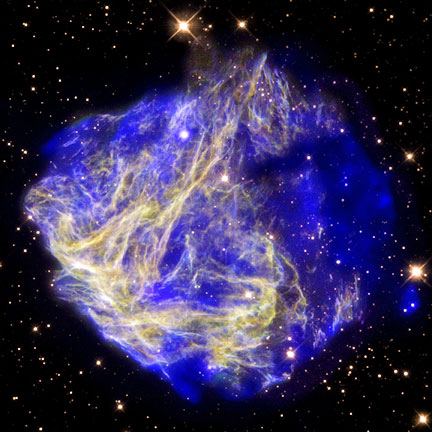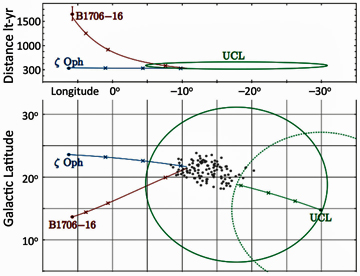|
Scientists from Germany and Armenia published new evidence that a nearby, recent supernova blasted Earth with the detritus of a massive star, some of which was radioactive.

(We have no image of that supernova, but the debris of a different supernova is shown here.)
You won’t hear this on the evening news because by nearby they mean within 2000 trillion miles (337 light-years), and by recent they mean less than 2 million years ago.
There is no evidence this event adversely impacted life on Earth. Indeed, an estimated 40,000 tons of cosmic debris rains down on us every year. If that’s not enough, NASA says even more debris rains down from all the spacecraft mankind has launched. All that “dust” adds to Earth’s own volcanic ash, windborne sand, and pollen. And yet, we rarely notice.
How do we really know that such a cosmic event actually occurred?
Even before the new evidence, scientists had reason to suspect. Traces of a radioactive isotope of iron (Fe-60) have been detected in Antarctic snow, ocean-floor cores, lunar regolith, and cosmic rays. All that Fe-60 must have been produced recently.
Fe-60 has a half-life of 2.6 million years, so any Fe-60 that was in Earth or the Moon when they formed over 4 billion years ago would have decayed long ago. No natural process on Earth, or within a normal star, produces Fe-60 — the only known sources are supernovae, the catastrophic explosive deaths of very massive stars. Analyses of this trace radiation show Fe-60 must have come here at least twice in the last 3.2 million years, implicating nearby, recent, supernovae.
Astrophysicists Neuhauser, Giessler, and Hambaryan claim to have found the smoking gun — a runaway star and a radio pulsar. These two celestial objects are moving exceptionally rapidly through our galaxy, and appear to have a common origin.
Using high-precision stellar position and velocity measurements from ESA’s (European Space Agency) Gaia satellite, the authors traced numerous high-speed stars and pulsars back in time. They found one pair, star ς Oph and radio pulsar B1706-16, whose trajectories intersected 1.8 million years ago in an association of massive stars named UCL (Upper-Centaurus-Lupus). These charts show where ς Oph (blue), and B1706-16 (red) are today (on the left) and where they were previously. UCL has moved from the solid green circle to the dotted circle today, but its distance from Earth hasn’t changed.

The axes of the lower chart are galactic latitude vertically, and longitude horizontally. The upper chart has the same horizontal axis, and plots distance from Earth in light-years vertically.
The authors estimate the odds of this being a random fluke are less than 1 in 10,000. They propose these objects are the remains of a binary star system — two massive stars orbiting one another. One star exploded in a supernova, blasting its guts across the heavens, reducing its core to a pulsar — an intensely magnetized, rapidly spinning, neutron star. The explosion sent the pulsar and its stellar partner flying apart at high velocity.
The supernova was close enough to spray its neighborhood, including Earth, with many common elements and some exotic products, such as Fe-60.
Will this ever happen again? Yes, given enough time. Some pundits claim a supernova close enough to us to cause mass extinctions might occur once every 250 million years. [It really can’t be much more often than that. IIn the last 600 million years, there have been 5 mass extinctions of multi-cellular animal life on Earth, and supernovae are only one of many extinction threats.]
Best Regards,
Robert

May 2021
Note: Previous newsletters can be found on my website.
|